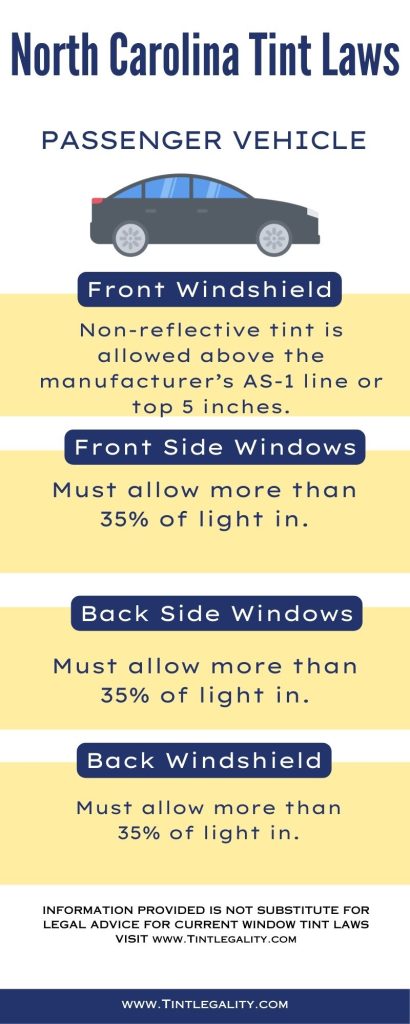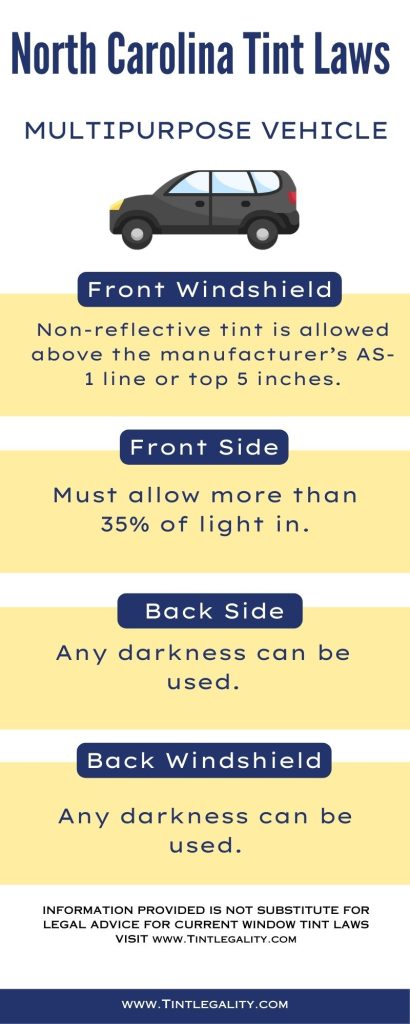North Carolina tint laws were enacted in 2001, stipulating specific regulations on the tinting of windows for vehicles.
These laws are essential for maintaining visibility and safety on the roads, yet many vehicle owners remain unaware of them.
So, let’s dive into the comprehensive review of these laws to give you a detailed understanding.
North Carolina Window Tint Law
The rules surrounding the window tinting of vehicles in North Carolina are codified under state law.
The key goal behind these regulations is to maintain a balance between the privacy of car owners, aesthetics, and safety for all road users.
This balance ensures sufficient visibility for drivers, regardless of the time of day or the prevailing weather conditions.
Regulations Regarding Window Tint in North Carolina
Window tinting regulations in North Carolina cover various aspects, ranging from the windshield to the side and rear windows.
These laws also encompass additional stipulations regarding reflection, color restrictions, and medical exemptions.
| Aspect | Regulation |
|---|---|
| Windshield | Non-reflective tint allowed above the AS-1 line |
| Front Side Windows | Tint must allow more than 35% light inside |
| Back Side Windows (Sedan) | Any tint darkness allowed |
| Back Side Windows (SUV and Vans) | Tint must allow over 35% light inside |
| Rear Window (Sedan) | Any tint darkness allowed |
| Rear Window (SUV and Vans) | Tint must allow over 35% light inside |
| Reflection | Tint must not be more than 20% reflective |
| Medical Exemptions | Exemptions allowed with relevant proof |
| Color Restrictions | Red and amber tints are not allowed |
| Side Mirrors | Required if the vehicle has a rear window tint |
Windshield
In North Carolina, non-reflective tint is allowed along the top of the windshield, typically above the manufacturer’s AS-1 line.
This rule helps in reducing glare, promoting safety and convenience for drivers.
Front Side Windows
For front-side windows, North Carolina tint laws mandate that the tint must allow more than 35% light inside.
This stipulation ensures that drivers have a clear view of their surroundings, which is crucial in preventing road accidents.
Back Side Windows
Unlike front-side windows, North Carolina tint laws are more lenient when it comes to back side windows.
They allow any tint darkness for sedans, while for SUVs and vans, the tint must allow over 35% of light inside.
Rear Window
Just like the back side windows, any tint darkness can be used on the rear window for sedans.
However, for SUVs and vans, the rear window tint must permit over 35% light inside.


Additional Regulations
Beyond the basics, North Carolina tint laws offer extra stipulations concerning reflection, medical exemptions, and color restrictions.
These additional regulations ensure road safety, protect citizens’ health, and maintain the aesthetic standard of vehicles.
Reflection
When it comes to reflection, North Carolina tint laws allow only a certain level of reflectiveness in window tints to prevent the creation of mirror-like effects that could blind other drivers.
For both front and back side windows, the tint must not be more than 20% reflective.
Medical Exemptions
In some cases, individuals may receive medical exemptions to the standard North Carolina tint laws.
For instance, if a person suffers from a medical condition like photosensitivity, they can apply for a waiver that permits them to have darker window tints.
Color Restrictions
North Carolina tint laws restrict certain colors from being used for window tinting.
Specifically, red and amber tints are not permitted as they can interfere with traffic signal recognition and create confusion on the roads.
Side Mirrors
In addition to window tints, North Carolina laws stipulate that if a vehicle has a rear window tint, it must also have dual side mirrors.
These mirrors are necessary for maintaining visibility and ensuring safety on the roads.
Exceptions to Legal Limits
While the rules are clear-cut, there are certain exceptions.
Some vehicles, such as those used for medical or law enforcement purposes, may be granted exceptions to these legal limits.
Penalties for Breaking the Law
Ignoring or disobeying North Carolina tint laws can lead to various penalties, from fines to other penalties, depending on the number of convictions.
Fines
First Conviction
Upon the first conviction, offenders face a fine of $200.
Second Conviction
A second conviction within three years of the first results in a fine of $300.
Third Conviction
The third conviction within five years can result in a $500 fine.
Other Penalties
Other penalties for non-compliance with North Carolina tint laws include a misdemeanor charge and potential probation or even jail time for multiple offenses.
The severity of these penalties underlines the importance of adhering to the regulations.
So, for all North Carolina residents and drivers, it’s essential to be aware of these laws, their implications, and the potential penalties for non-compliance.
Doing so will not only ensure your safety on the roads but also save you from potential legal trouble.
Faq’s
Can you get pulled over for 5% tint in NC?
Yes, you can be pulled over for 5% tint in NC, as it violates the 35% light transmission rule.
Is tint still illegal in NC?
Tint is not illegal in NC, but it must meet specific regulations.
Can you get a ticket for dark tint in NC?
Yes, you can get a ticket for excessively dark tint in NC.
Is 15% tint illegal in NC?
Yes, 15% tint is illegal in NC if it does not allow more than 35% light inside.
References:
https://en.wikipedia.org/wiki/North_Carolina
https://www.ncleg.gov/EnactedLegislation/Statutes/PDF/BySection/Chapter_20/GS_20-127.pdf
https://www.ncdot.gov/dmv/downloads/Documents/tinted-window-waiver.pdf